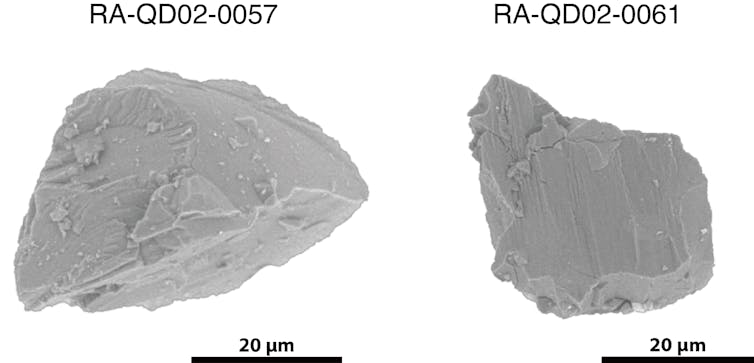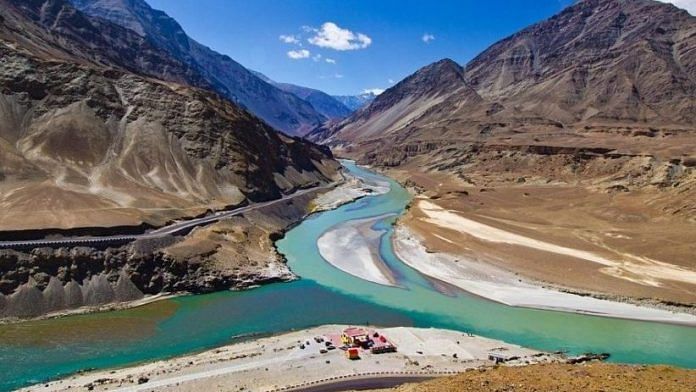Water is essential for life on Earth and is one of our most precious natural resources. But considering how our planet formed, it is quite surprising how much water we still have. The Earth aggregated from a cloud of gas and dust – a protoplanetary disk – and was incandescently hot for the first few million years. Its surface was kept molten by impacts from comets and asteroids. Earth’s interior was also (and still is) kept liquid by a combination of gravitational heating and the decay of radioactive isotopes.
That means that if there were any initial water (and organic compounds) on the Earth, it should have boiled off quickly. So how come there’s plenty of water on our planet today – where did it actually come from? A surprising new study, published in Science Advances, suggests that a type of asteroid we didn’t think contained very much water could be responsible – simultaneously demonstrating that the solar system is probably a lot wetter than had previously been thought.
Scientists have long debated exactly where the Earth’s water comes from. One theory suggests that it might have been captured from the asteroids and comets that collided with it. Another argues that water was always present in the rocks of the Earth’s mantle and was gradually released to the surface through volcanoes.

Thanks to the Japanese Hayabusa mission we now have fresh evidence. The spacecraft brought back a precious cargo of grains retrieved from the surface of asteroid 25143 Itokawa in 2010. The researchers behind the new study were able to analyse the water content of two grains. They used a sophisticated piece of kit called an ion microprobe, which bombards a sample with a beam of ions (charged atoms) in order to probe the composition of its surface.
The experiment was not easy – the grains are tiny, less than 40 microns (one millionth of a metre) across, and each grain was made up of several different minerals. The ion microprobe had to be focused on one specific mineral within each grain so that the authors could gather the required data. The species of mineral that they analysed was an iron and magnesium-bearing silicate known as a pyroxene, which is almost entirely free of calcium.
This type of substance is not usually associated with water – indeed, it is regarded as a Nominally Anhydrous Mineral (NAM). The lattice of a pyroxene crystal does not contain vacant sites for water molecules in the same way that, for example, a clay mineral does – so its structure is not necessarily conducive to taking up water. However, the sensitivity of the technique that the authors used was such that they could detect and measure tiny quantities of water.
The results were surprising: the grains contained up to 1,000 parts per million of water. Knowing the composition of Itokawa, the researchers could then estimate the water content of the entire asteroid, which translated to between 160 and 510 parts per million of water. This is more than had been anticipated – remote measurements of two similar bodies (also S-type asteroids) found that one contained 30 and the other 300 parts per million water.
Unlikely source
Water is made from hydrogen and oxygen. But those elements occur as different isotopes – meaning they can have a different number of neutrons in their atomic nucleus (neutrons are particles that make up the nucleus together with protons). The researchers looked at the hydrogen isotopic composition of the water and discovered it was very close to that of Earth, suggesting the water on Earth has the same source as that of the Hayabusa grains.
The results raise several interesting questions, the first of which is how so much water came to be in nominally anhydrous minerals? The authors suggest that, during their formation, the grains absorbed hydrogen from the protoplanetary disk, which, at the high temperatures and pressures of the solar nebula, combined with oxygen in the minerals to produce water.

Japan Aerospace Exploration Agency (JAXA), edited by Z. Jin
So far, so reasonable. But how is it possible that the water has remained in the minerals? They after all came from an S-type asteroid – one that forms in the inner and hotter part of the solar system. Itokawa has had a complex history of thermal metamorphism and collision, reaching temperatures at least as high as 900°C. But the researchers used computer models to predict how much water would be lost in these processes – and it turned out to be less than 10% of the total.
Earth’s water
But how does all this relate to Earth’s water? The researchers speculate that following the grains’ uptake of water from the protoplanetary disk, the minerals aggregated and stuck together to form pebbles and eventually larger bodies such as asteroids.
If this mechanism worked for asteroids, it could also hold true for the Earth – maybe its original water came from these minerals coming together to help form the Earth. While water was then lost during the Earth’s early history, it was added again during collisions by the numerous S-type asteroids – as implied by the similarity in hydrogen isotopic composition between Earth and Itokawa.
This fresh look at an old problem – the origin of Earth’s water – has produced a surprising conclusion, one that suggests a large population of inner solar system asteroids might contain a lot more water than had been realised.
So while there is water everywhere in the solar system, the fact that it is hidden away inside minerals means that there is not always a drop to drink.
Monica Grady, Professor of Planetary and Space Sciences, The Open University
This article is republished from The Conversation under a Creative Commons license. Read the original article.
![]()







Every day I keep on hearing and reading different articles about the different aspects of universe through different scientists and experts.
So one thing gives me a clear indication that all are Confuesd about the formation of this universe as how it was originated
And believe me in coming times also billions of money will be spent on this research but still the confusion will be there
I think it’s very possible that comets and asteroids may have contributed to Earth’s water. And I also think it’s possible that the Earth itself may have created its own water, possibly through volcanic activity.
I don’t know a whole lot about science, I’ve been an automotive mechanic most of my life. One thing I’ve always noticed, is that when the air and fuel mixture that enter a cylinders engine is exact and the combustion is complete, out from the tailpipe drip clear water and lots of it. Can someone help explain my way of thinking. Thank you
I’ll get to the Bible part in a minute, but my understanding is that after the Hadean period (molten time, many asteriod impacts), various comets and asteroids delivered water to earth to the point of it being totally covered, like a 100 times deeper than today — UNTIL — the Theia collision event (body slams into earth) which basically stripped earth of all of its atmosphere and water. Later, planetesimals deliver the water again. Then, tectonics slowly has land emerge.
Actually, compared to watery exoplanets (water of 8-50%), earth has a rather low percentage of water: 0.045–0.251 percent, of which just 0.02 percent is surface water. So, yes, asteroids are responsible for water for earth. Comets are 80% water, and asteroids it was though was about 20%. I suppose the discovery is that asteroids are wetter than we thought. No problem, and that explains how we still got a lot of water. BTW, typical water exoplanets are covered with super deep water and no land, which will not allow for advanced life.
Biblically, I have no problem with Genesis (any of it). Properly interpreted, it matches the science amazingly well. God is a lot smarter than we are anyway.
Just saying God created Water will do for a kid, but better answers are needed when we grow up. The asteroids answer is a better one. Let’s try to get still better ones using the intelligence we find that we possess, perhaps given by God for this very exercise.
let’s forget from where did water come and instead save it.
An asteroid had nothing to do with the water on Earth. We don’t have to struggle so hard to accept God’s hand in our existence.
Praise the Lord.
People says astroids may be the reason why earth has water ..but real fact is1) do u know how seas has formed?,2)why sand instead mud? Scientists says world is created it’s self.
But actually the reality is this whole world is
With darkness,water has no gap between heaven ,earth,than GOD told let there be light,all darkness vanished,than GOD told let there be dry land,all the water begun to form as (SEA) ,dry land appeared..,he so it’s good,he named dry ground as earth,above is heaven,only one big can explain every mystery of earth that is Bible…,people says many but every true word ,secret found in only Bible…(Genesis 1:9-10 King James Version (KJV)
9 And God said, Let the waters under the heaven be gathered together unto one place, and let the dry land appear: and it was so.
10 And God called the dry land Earth; and the gathering together of the waters called he Seas: and God saw that it was good.)